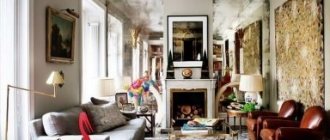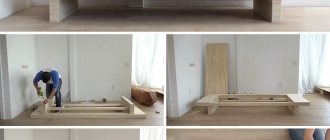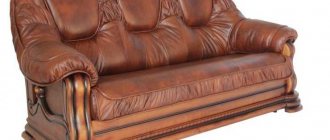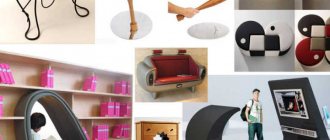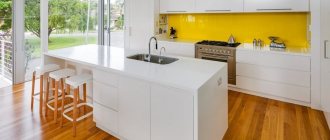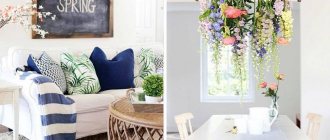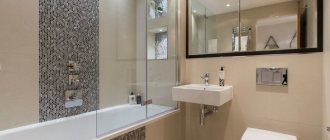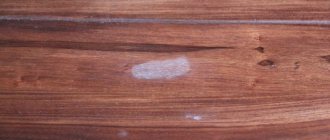Modern sofas are a reflection of new interior styles that have emerged over the past 60-70 years. This is not one style decision, but several trends: art deco, modern, hi-tech, kitsch, loft, minimalism. They are united by functionality, which prevails over decorativeness (first - convenience, and only secondarily - beauty). Another common feature is the lightness and simplicity of forms, which contrasts modernism with more complex and elaborate classics.
Rules for choosing a sofa for the living room Read more >
Modern sofas are chosen by people who want to emphasize their progressive views and ability to follow trends. These are young specialists from both creative and technical professions. Often, furniture in new styles goes beyond the usual forms and canons: modern sofas may be completely different from classic designs. There is complete freedom of shape: corner, semicircular and round models; any geometry of armrests and backrests; bright colors and bold prints.
Center of a modern living room
Modern sofas for living rooms are made in different materials, from the most economical to premium. But even expensive models made from natural materials do not create the impression of pomp and luxury - more often they immerse you in an atmosphere of comfort and coziness. Therefore, if you want to make an impression and talk about your wealth, the classics are more suitable for you. A reasonable compromise is an art deco style that is both respectable and functional.
Having decided on the design of the room, start choosing furniture. In a modern style, you can now furnish any room, from the kitchen to the bedroom and bathroom (many manufacturers have corresponding collections of furniture and accessories), but we will talk about the living room and especially about its most important item - the sofa.
The sofa is compositional. Therefore, it is crucial for creating her appearance. Before buying it, decide which trend of modern design you prefer. Choose a sofa so that it matches the chosen style, and other pieces of furniture, textiles and accessories so that they do not conflict with it.
Popular materials and colors
Its wear resistance and service life depend on the upholstery of the sofa. The variety of materials used in the manufacture of modern upholstered furniture is wide:
- Natural fabrics - jacquard, tapestry. They guarantee good ventilation, are environmentally friendly and hypoallergenic. However, they are very delicate and demanding to care for. Most often, they are not suitable for intensive use and quickly lose their refined or luxurious appearance. For this reason, protective covers are used for such sofas.
- Artificial materials obtained through chemical synthesis do not require complex care and allow you to create any fashionable shades. Due to wear resistance, easy cleaning, almost complete absence of shrinkage and long-term preservation of color saturation, Alcantara, chenille, artificial suede, and microfiber are especially popular.
- Genuine leather remains a luxury type of sofa upholstery; it is durable, moisture-resistant, and easy to care for. However, leather sofas have a significant drawback - a very high price.
- Modern substitutes - eco-leather and two-tone leather - are not inferior in properties and appearance to the original, but are extremely cost effective.
Characteristics of anti-claw fabric for sofas, main varieties
Upholstery made from natural fabrics
Leather sofa
Artificial upholstery Upholstered furniture made of eco-leather
Since the sofa in the interior is the central point that attracts the main attention, it is important that its shade fits harmoniously into the surrounding environment. Typically, one of the following principles is used:
- matches the overall color palette of the room;
- combination with several basic items;
- absolute difference from the general background.
In the first case, designers advise starting from the colors of the walls, maintaining differences in shades. For example, a sofa with beige upholstery will go well with white surfaces with a slight yellow tint, a soft corner in a richer blue-gray hue will go with serenity walls, and a stylish sofa in a rich cherry color will be the “king” of the interior in a room with soft pink wallpaper.
Characteristics and advantages of the Friheten sofa from Ikea, model range
In the second case, the color of the main interior elements, in addition to the walls, is taken into account. This could be curtains or other existing furniture. So, with the right selection of shades in the art deco or kitsch style, even a pink sofa accompanied by curtains of a slightly darker shade will look great against the background of blue walls, adding a little elegance to their tranquility.
The third option requires a special sense of proportion and taste. Specialists use an additional scheme to select bright, accent colors, choosing tones that complement each other on the color wheel, for example, blue and yellow-orange, purple, yellow. So, an original scarlet sofa can become the warmest and most attractive place in a room with a general gray-brown background.
For many styles, it is important to have decorative elements that emphasize the importance of furniture:
- wooden armrests and legs with carved patterns;
- decorative upholstery nails, buttons.
Pillows are the simplest, but very fashionable option for decorating sofas today. You can choose a set in any style to your taste - simple or with frills, embroidery, plain or contrasting, made of fabric or leather - and from an ordinary one you can create not just a beautiful sofa, but a unique, one-of-a-kind sofa.
Universal sofa decks for armchairs and sofas, product classification
The color of the sofa matches the overall interior
The colors of the furniture and the design of the living room echo each other. The sofa serves as a bright accent.
Modern sofa styles - characteristics
Let’s take a closer look at modern styles in design and interior design. Here are the trends that fashion historians highlight:
Art Deco
Appeared during the era of fashion for cubism - in the 50s of the last century. It combines monumental forms of furniture and elegant interior decorations. Wide armrests, gracefully curved backs, thin legs and “straps” (decorative buttons) are the typical features of an art deco sofa. The style is romantic, elegant and quite respectable.
<
>
Modern
Translated - “modern”: formed at the beginning of the 20th century, also known as Art Nouveau and Modernissimo. Its peculiarity is its plastic form with an abundance of curved lines and the obligatory “aesthetics” - decoration, which is manifested in the beautiful glazing of cabinets and elegant furniture fittings. “Modern” is sometimes a general term for all modern interior styles, as opposed to “classic”.
<
>
High tech
Translated - “high technology”. It manifests itself in the choice of shapes and materials: obligatory chrome and glass parts in furniture, simple rectangular shapes. The sofa can be similar to car or airplane seats; this “technogenicity” is also typical for high-tech.
<
>
Loft
Translated - “attic”: a style characterized by open spaces and industrial elements (pipes, ventilation shafts, brickwork). For lofts, large island sofas are usually chosen, which help to zone the room without partitions.
<
>
Kitsch, eclecticism
Bright styles in the aesthetics of postmodernism, with a mixture of colors and textures, an abundance of unusual details and “quotes” from other movements, up to Baroque and Empire. Creating such interiors requires great taste, because it is easy to lose a sense of proportion and end up with a disparate set of individual items.
<
>
Minimalism
The interior is without unnecessary details, designed in simple geometric shapes. In such an interior there is a minimum of decorations and only the necessary pieces of furniture. A typical minimalist sofa is modular, assembled from individual geometric blocks.
<
>
What styles of furniture and interior are there?
At different times, people tried to decorate and ennoble their homes, often in order to surprise guests.
Fashion included certain things and objects that were absorbed by a certain style, subsequently becoming a canon in art and everyday life.
We bring to your attention a number of currently popular interior styles.
Gothic.
13th-14th centuries. Majestic, awe-inspiring style.
Speaking about this style, it should certainly be noted that he took a lot from the church setting.
And no wonder, since it was in those times that the dominance of the church was unshakable.
In the interior, preference is given to dark shades.
At the same time, there must be an abundance of light.
For example, a large chandelier can be the main source of lighting.
The Gothic interior is characterized by carved doors and high arches, large fireplaces, stucco moldings, and stained glass windows.
All this should create a special mystical atmosphere of a medieval castle.
Paintings, tapestries and frescoes are used to decorate the walls.
Also used for decoration are items from the “epoch”: cups and vases, ancient weapons and candlesticks, massive mirrors and torch-shaped lamps.
The furniture is characterized by the presence of carved legs and upholstery in the appropriate colors.
The furniture may be simple, but it is very heavy.
Often furniture facades were covered with painting.
Typically, it was during this period that clothes began to be stored in closets.
Material : oak, walnut, spruce or pine, cedar.
Baroque.
from the end of the 16th to the beginning of the 18th centuries. Translated from Italian as “bizarre.”
First of all, luxurious. Furniture is perceived as a piece of art and decorates the interior.
Considering the features and scope of this style, it is not suitable for small rooms.
In a small interior, you can use only individual elements of the Baroque style.
To create luxury, only expensive finishing materials are used: marble, precious wood, ivory, crystal, etc.
The presence of volumetric stucco molding, vaulted structures and columns is required.
As a rule, lamps should give a diffused and muted color.
For decoration, exclusively pastel colors are used.
Furniture in the Baroque style is necessarily decorated with gilding and has a lot of carved details.
The presence of upholstery made of decorative fabrics, fringe decorations.
For example, the well-known large canopy beds, wardrobes of incredible sizes, chairs with carved backs.
However, in the 21st century it is not at all necessary to order quite expensive wooden furniture to create an interior in a similar style.
Similar furniture can be ordered from plastic, which in its physical qualities is hardly inferior to wood.
We invite you to view the catalog of decorative elements made of plastic for creating furniture.
Material : walnut, ebony.
Classicism.
18th - 19th centuries Perhaps this style has never been and, perhaps, will not be subject to fashion trends.
Strict forms and proportions. Everything is simple and clear, a minimum of decor.
The features of this style are massive structures with regular shapes and light colors.
Columns, ornaments and statues are often used in the interior.
Stucco molding, paintings, and paintings are used to decorate walls.
Also used are pilasters and semi-columns, frescoes and ornaments.
The furniture is made of valuable wood, has thin elegant legs, and expensive fabric is used for upholstery.
Material : noble wood species are preferred.
There is often inlay with rare types of wood, gilding or carvings.
The natural color of the wood predominates.
Empire style.
late 18th - early 19th centuries Empire (“imperial style”) - appeared in France during the reign of Emperor Napoleon.
To create this interior in this style, it is necessary to have a large area.
A combination of two colors is mainly used - white and gold. Moldings and stucco moldings, columns are used for decoration.
The walls are decorated with majestic huge mirrors and portraits. Empire style is characterized by high ceilings and massive chandeliers.
The royal style in furniture is characterized by the presence of decorative bronze plates, for example, in the form of lion paws.
At first, they tried to give the furniture a lush, pompous look, not at all bothered by the fact that it should also be comfortable.
Empire style furniture is distinguished by its sophistication. Furniture from ancient Rome and Greece is often copied.
It is made from precious wood and often has gold-plated ornamental decorations.
Material : mainly mahogany.
Modern.
late 19th - early 20th centuries In general, this style can be easily characterized as a rejection of angles and straight lines.
It is important to show streamlined shapes. Natural curves in everything: be it the frame or, say, fittings.
Moreover, the latter should be quite elegant. Similarities with the natural world - animals, insects, trees.
The main material for decoration is wood. Often there are elements made of forged metal.
Stained glass, glass, and stucco are also used and are not alien to the Art Nouveau style. The light is dim and soft.
The furniture is distinguished by smooth, rounded lines.
Material : wood.
Functionalism.
early 20th century As the name implies, the furniture is extremely functional. The emphasis is on convenience. Form determines function.
For example, the chair follows exactly the line of the back. All designs are original.
Simplicity and comfort in the interior. Some decorative elements have specific functions.
Built-in niches and shelving are used.
The furniture is quite cheap and generally available. The popular transformable furniture is often used.
Made from high-tech materials .
Minimalism.
20th century Extreme simplicity of design. Simple lines are mostly strict shapes, right angles.
Little furniture, minimal furnishings - all this for the sake of freeing up space.
The less furniture and any elements in the interior, the better it is.
The predominant color is white, because it is the color that can fill the space with “air,” but there is also black, which emphasizes the contrast, and gray.
Characteristic is the lack of decor: a minimum of paintings, vases, pillows, lamps, etc.
Transformable furniture is also often used.
There is also designer furniture specially designed for this style.
materials are simple.
Country.
This “rustic” style appeared in the United States of America.
Stylization for the interior of a country house, a house in the village.
The characteristic features of this style are simplicity and comfort.
The color palette consists entirely of natural shades, and the furniture and decorative elements are made from natural materials.
Elements of a particular culture or ethnic group can be used for decoration: clay pots, ceramic dishes, forged candlesticks, wicker baskets, stuffed animals, etc.
Both wicker furniture and furniture with forged elements are welcome.
It is not uncommon to have pillows and bolsters on sofas.
The materials used are exclusively natural.
Pop Art.
1950 - 1960 Quite fashionable “pop-art” style. The style itself does not allow any templates.
This style mainly includes sofas and beds.
When decorating a room, plastics and other artificial materials are mainly used.
Bright, contrasting colors predominate, designed only to improve mood.
In an interior decorated in this style, much attention is paid to decorative elements: photographs, jewelry, souvenirs, figurines, etc.
Furniture of non-standard shape made from inexpensive materials or maybe even frameless furniture.
Materials : leather, no matter what - natural or artificial, synthetic.
High tech.
end of the 20th century Modern technologies are the main criterion.
And the interior is more reminiscent of the decoration of a spaceship.
The predominant color is white. Particular attention is paid to lighting.
Which matches the style and represents the latest technological achievements.
The furniture has simple geometry and is functional.
All this makes the furniture look like equipment, as if merging with it into one whole mechanism.
There is no decor as such.
Materials : glass, plastic, metal.
Ethnics.
Of course, there are folk elements.
Symbols inherent to a particular state and its history, which give a very exotic look to the interior.
Furniture should also be in harmony with the chosen culture and fit into the interior.
Materials should also be as consistent as possible with the culture of the country.
Eclecticism.
The name itself means confusion. Indeed, there is a mixture of different styles.
This style is timeless.
Because one way or another, a mixture of styles when building a particular interior still occurs.
It all depends on the designer and his ability to competently and smoothly combine styles and avoid conflict between them.
Features of sofas in a modern style
A typical feature of upholstered furniture these days is that you are not tied to certain materials and colors. If too bright fabrics and bold textures (for example, fluorescent colors, metallics, perforated leather) are not suitable for the classics, then here you can not deny yourself anything. Plastic and chromed metal can also be safely used. All that is important is to maintain the unity of the chosen style and create a palette in the room that is comfortable for the eye.
The second difference is functionality: not all classic styles allow the use of corner and folding sofas, and modular furniture for a traditional interior is quite difficult to imagine. And modern sofas can accommodate any number of guests, occupy a corner or niche and, if necessary, become a sleeping place.
Modern furniture styles: brief description
Fashion trends in furniture of the late 20th and early 21st centuries were formed under the influence of technological progress and the fast pace of life. Modernity began to dictate new conditions: a huge number of new industrial products appeared, and the need arose to optimize housing space. Modern furniture styles are an organic combination of aesthetics with reasonable versatility, often used synthetic materials, unusual shades.
Innovative developments and the scientific and technological revolution of the 20th century contributed to the emergence of practical materials that became the basis for the manufacture of furniture: plastic, durable glass, rubber, metals, artificial fabrics. Thanks to the developed chemical industry, it became possible to paint things with colors of bright, unusual shades that are not found in nature.
Among the main furniture styles that have appeared relatively recently: high-tech, minimalism, loft, avant-garde, pop art, country and boho style, the Scandinavian trend “Scandi”, constructivism.
Modern
A favorite trend of bohemians, consisting of wavy, sinuous lines of furniture. The furniture is made in exquisite colors, mainly made of wood or forged metal. Elements are often inlaid with mother-of-pearl. Characteristics of the style: stained glass, glass, floral patterns, artificial materials. Art Nouveau is unthinkable without the many trinkets that are present everywhere.
Minimalism
Simplicity and conciseness are the main motto of decorating furniture in a minimalist style. The furnishings are designed to fill the maximum amount of air and free up space, so all elements have minimal decor, right angles and convenience. Preferred achromatic colors: white, black, gray. Brown, sometimes khaki and sand are allowed. Furniture elements are made of wood with leather, glass or chrome inserts; they can transform and hide. Various vases, cornices, buttons, lamps and other decorations are missing. For decor, only accent sofa pillows are possible.
Minimalistic hall interior
High tech
The style of high technology and functional furniture. Sliding and built-in wardrobes, transforming soft modules, transforming sofas, and armchairs that follow anatomical shapes predominate. All surfaces are glossy, mainly metallic, silver shades, complemented by bright red, blue, and green colors. High-tech is built with straight lines and artificial materials, original tables and chairs. Furnishing materials are plastic, glass, metal, concrete, occasionally leather and wood. The role of decor is played by kitchen appliances, audio and video equipment.
High-tech in the interior
Loft
The loft is easily recognizable by its unplastered brick walls and high ceilings. From English the word “loft” is translated as “attic”. The style appeared thanks to artists and other representatives of bohemians who settled in the attics of industrial buildings in the 60s, which is why it received such a name. Industrial premises inhabited by creative people acquired a special bohemian chic, which became fashionable, spreading everywhere. Loft excludes complete furniture sets, combining disparate furnishings made of glass, chrome and wood. Here, old or specially aged modules are combined with modern household appliances and fluorescent lamps.
Color shades: gray-brown, white, pastel. Bright accessories are acceptable: colorful pillows, books, watches.
Constructivism
The style of constructivism is based on practicality and the use of functional furniture: chair-beds, pull-out tables. Materials of furniture elements - plastic, glass, metal. In constructivism, the geometric shapes of objects are clearly observed, and convenience comes first. All the furniture seems to merge with the surrounding room thanks to the color schemes. Only 3 shades of color are allowed in the interior; monochrome is present in everything. Black, grey, green and red predominate. Constructivism in the interior - high floor-to-ceiling windows, blinds, plain wallpaper. The space is zoned with furniture and easily moving partitions; the living room is combined with the kitchen.
Vanguard
The innovative direction of furniture suits creative and young individuals. Interior elements are made from artificial materials and various geometric shapes: stripes, cubes, circles, rings. Avant-garde is based on contrastingly decorated walls, windows and doors, a bright color palette: red, green, blue and purple, and original decor.
Furniture is always of unusual design, often made according to individual projects
Pop Art
Pop art style does not allow patterns; plastic, leather and synthetics are widely used in decor. The room is furnished with objects of unusual shapes and bright colors, frameless furniture is used. On the walls there are many posters and pictures of pop stars. This glamorous style arose in the 50s of the 20th century, built entirely on details and flashy colors, flavored with Hollywood glamor.
Furnishing elements have a bright gloss and contrasting shades
Eco style
The main principles of eco-style, which came into fashion after the worship of synthetics, are closeness to nature. Therefore, when organizing the interior and furnishing, exclusively natural materials are used everywhere: stone, solid wood, knitted blankets, straw rugs, linen textiles. A characteristic feature is wicker furniture made of wicker, rattan, wood, and forged.
The interior is complemented by buffets in the kitchen with ceramic dishes, wicker baskets, and wall still lifes.
Ethnic style
Interior design in the style of a certain nationality is usually called ethno-style. The most popular national styles: Japanese, Scandinavian, African, Moroccan, Mexican.
The basis of the furniture style is the interior traditions of the chosen nation or state
Country
This is a rustic country house style with whitewashed or wooden ceilings, walls and brickwork. The basis of country music is simple furniture made of rough solid wood, wicker materials, complemented by forged elements.
The main condition is the absence of synthetics, natural shades without gloss and varnished surfaces.
Comfort comes from small soft sofas, armchairs and plenty of textiles.
Eclecticism
Furnishing in an eclectic style involves mixing items of different styles into a single organic whole. To combine, they use objects related to 2-3 directions, arranging each other according to texture, color and architectural form.
Eclectic interior elements have dynamic twisted shapes and are decorated with wooden carvings
The modern variety of styles will allow anyone to furnish a house or apartment with furniture to their taste. Remember that there is room for creativity everywhere, so you don’t have to strictly adhere to one direction. Bring your own notes into the interior, add original accents, then the room will become unique and original.
Materials and colors of a modern sofa
When buying a modern sofa, you are practically unlimited in the choice of color and material. But there are features in different directions that are important to consider. Here are some tips from interior designers:
- If you choose minimalism, give preference to plain sofas. Don't get carried away with patterns or combinations of several colors in one piece of furniture.
- Art Deco is the most elegant of modern styles. For such sofas, fabrics with floral prints, patterns of intertwined lines, and damask patterns are used. The predominant color scheme is light (white, gray, beige, light purple).
- A leather sofa, especially if it is massive and leans towards retro, will fit perfectly into a loft space.
- Colored leather, artificial leather or vinyl as sofa upholstery will fit well into a modern or high-tech interior. And especially bright shades are suitable for kitschy interiors.
Sofa styles in the interior
- Chesterfield
- Sofa in cabriolet style
- English rolled arm
- Venetian and Victorian sofa
- Baroque
- Gothic
- Rococo
- Empire style
- Victorian
- Modern or Art Nouveau
- Colonial
The Chesterfield model was created in Great Britain at the beginning of the twentieth century. This sofa has a rounded back and armrests, wooden legs and capito style upholstery. The upholstery can be made of natural or artificial leather, as well as velvet, velor or flock.
In 70% of cases, such furniture is placed in an office or living room, which is designed in English or Victorian styles, or with a loft finish. The upholstery is most often made of leather in brown, black or dark red shades. Modern designers creating neoclassical interiors prefer sofas covered with velvet or flock. In this case, the furniture will have colors unusual for this style: purple, emerald, dark blue, burgundy, fuchsia and other rich and sensual shades.
Externally, the sofa looks very impressive. It seems as if it is drawn with one continuous line. Such furniture was common in the first half of the 18th century, and it could often be seen in interiors designed in the spirit of Louis XV and Queen Anne.
The main features of a convertible style sofa:
— It has curved legs, the finishing is made of wood, and there are no cushions.
— Modern models are more practical, so they do not have unnecessary decor, and the upholstery has become soft and cozy.
— The convertible fits harmoniously into rooms with French-style interiors. It also goes well with kitsch, fusion, and glamour.
Another modern style of sofas in the interior is English rolled arm. This is an English sofa with rounded armrests. It is suitable for interiors designed in neoclassical or English styles.
Traditionally, upholstered furniture has plain upholstery in natural shades, for example, beige, green, brown, yellow. Brighter colors are now becoming popular. Dense, rough and inexpensive textiles are most often used as upholstery material.
This model of sofas is ideal for creating classic interiors, for example, Baroque, Rococo, Victorian, Venetian, Moorish and others.
Distinctive features of a classic sofa are rounded armrests, similar to semi-spirals, oval backrests with cut edges and wooden edging, gilded or silver. The upholstery is made from good quality fabric, most often with a large floral print.
Such furniture is always decorated with rich decor. This can be masterfully executed carvings, metal figures, as well as mosaics made from several types of wood. The legs of sofas have an ornate configuration, often shaped like animal paws. For upholstery, tapestry fabric, brocade, velvet or silk are used.
As in any other country, in Russia Baroque acquired national characteristics. To imagine what this architectural style looks like, remember the scenery for Russian fairy tales. As a rule, interior items are richly decorated with carvings and multi-colored paintings. The same features are found in modern sofas in the Russian Baroque style.
In general, furniture in the Gothic style is characterized by some bulkiness. The sofa, as a rule, has a high back and geometric armrests. Carvings with floral and architectural motifs, as well as a canopy on spiers, can be used as decoration.
Gothic style furniture is made of natural wood, the fittings are made of iron or bronze and covered with natural leather. However, now such leather is often replaced with artificial leather.
The Rococo style is considered the refined end of the Baroque era. During this period, new types of sofas appeared in the interior. For example, a “canapé”, which is several connected armchairs, a “burter” - a deep chair, and also a “chaise lounge”.
The decoration always contains decorative elements: carvings, stucco moldings, cupid masks. This era was characterized by fashion for China, so the upholstery is made from silk tapestries with designs of flowers, pagodas and traditionally dressed Chinese.
"Empire" means "luxurious" in French. This trend appeared in France during the Napoleonic era. Empire style is characterized by such features as restraint and orderliness. To create such an interior, mirrors, cornices and columns are used in large quantities.
The legs of the sofas look like the paws of a lion or elements of military props, such as spears or shields. Traditionally, Empire style furniture is made from mahogany. But now imitation is most often used.
The decorative elements and finishing contain details typical of antiquity. The ornament contains figures of people and animals, military paraphernalia and laurel wreaths. All wooden surfaces shine from careful polishing and have a bronze or gilded finish. The traditional empire color palette is quite bright: red, blue, white, gold and various dark shades.
There are several different directions of this style. In the USSR in the 30-50s, the Stalinist Empire style appeared, which is still in demand today. Its main features are pomp and solemnity, inherent in Baroque, late classicism, Art Deco and Empire style of the Napoleonic era.
This style of sofas in the interior is characterized by dark colors that contrast with light walls. Upholstered furniture is made of natural wood, has quilted leather upholstery or is lined with tapestry. In general, all interior items are made in a strict manner and have a minimum of decor. They exude the luxury and grandeur of a bygone era.
The Victorian style incorporated many architectural trends: Gothic, Baroque, Renaissance, Rococo, Empire, Neoclassicism. The period of its popularity coincided with the beginning of tourist activity. People began to travel a lot and brought new trends and unusual interior elements from other countries. All this formed the basis of the original “oriental style”.
Expensive varieties of mahogany are chosen for making furniture. Plush in burgundy, blue, green or brown shades is used as upholstery. Gilding is also actively used.
The end of the 19th and beginning of the 20th centuries is the time of Art Nouveau. The main idea of this movement in art and architecture is a return to nature. For this reason, images of plants and animals are often found in the decoration; smooth lines and a lot of stylization predominate. Although wood is still used to make furniture, modern materials such as glass and metal are becoming increasingly popular.
The sofas are decorated with floral motifs and patterns of wavy lines. The color palette is soft and calm: light pink, soft green, blue, ash.
The style originated in the colonial era, when England expanded its possessions to new territories in different parts of the Earth. The British picked up the cultural traditions of local residents and introduced borrowed elements into the decoration of their homes.
Colonial style always means natural materials and original interior items.
To create the necessary atmosphere, you can choose any model of sofas. The only condition is that it must be vintage. For example, furniture with a bulky classic frame, leather upholstery and multi-colored pillows is suitable here.
Pros and cons of modern sofa models
Unlike classics, which do not age, modern furniture tends to lose its relevance. And the bolder the interior, the greater the chance that in 5-10 years it will look old-fashioned. Therefore, be prepared for the fact that you will have to periodically update your living room in a modern style in order to stay “on trend”. But if you are really energetic and greedy for everything new, this will not be a problem for you, but an interesting challenge.
A clear advantage of modern sofas is their functionality. This is very comfortable furniture that fully meets the needs of people of the 21st century. Another advantage is its availability: even with a modest budget, you can create a cozy and stylish interior with a modern sofa in the living room, which cannot be said about the classics.
In search of harmony - a few words about placing a modern sofa in the interior
When you place a modern style sofa in your living room, you are not limited in any way. It can be placed along the wall, in a corner or in the center of the room; use for zoning; create a single composition from a sofa and armchairs (poufs) around a common center. The interior styles of our days are not tied to traditions and canons. The only criterion is your convenience.
<
>
